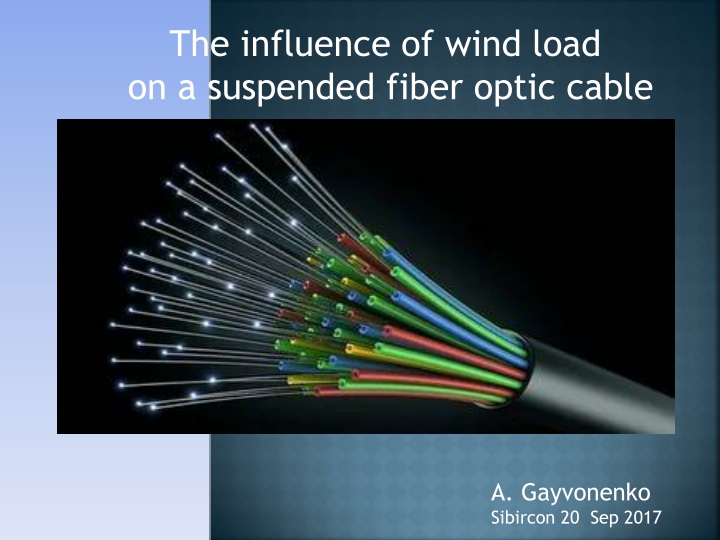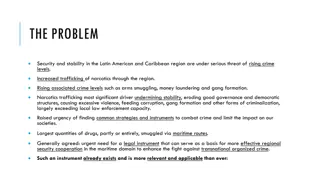
Influence of Wind Load on Suspended Fiber Optic Cable
"Explore the impact of wind load on suspended fiber optic cables and how precipitation, ice, and frost affect mechanical loads. Learn about calculating maximum wind loads based on wind pressure, span length, terrain type, and more factors in Russia. Understand the coefficients, tables, and formulas involved in determining the normative wind pressure for optimal cable performance."
Download Presentation

Please find below an Image/Link to download the presentation.
The content on the website is provided AS IS for your information and personal use only. It may not be sold, licensed, or shared on other websites without obtaining consent from the author. If you encounter any issues during the download, it is possible that the publisher has removed the file from their server.
You are allowed to download the files provided on this website for personal or commercial use, subject to the condition that they are used lawfully. All files are the property of their respective owners.
The content on the website is provided AS IS for your information and personal use only. It may not be sold, licensed, or shared on other websites without obtaining consent from the author.
E N D
Presentation Transcript
The influence of wind load on a suspended fiber optic cable A. Gayvonenko Sibircon 20 Sep 2017
The precipitation in the form of ice and frost have effects on the mechanical load of the fiber optic cable (FOC) suspended on the contact-line supports or power lines. It is therefore necessary to consider the effect of wind loads on overhead optical cable and calculate the maximum load, under the influence of wind. account for the effect of wind loads, we use the map of Russia for wind pressure. For this, based on the geographical location of the cable suspension, the required value for the maximum wind speed is selected according to the classification. 2
where: coefficient taking into account the inequality of the wind pressure over the fiber line; coefficient taking into account the influence of the span length on the wind load (intermediate values are determined by interpolation): with a span length of up to 50 m; at a span length of 100 m; at a span length of 150 m; at a span length of 250 m and more. - coefficient taking into account the change in wind pressure in height, depending on the type of terrain, determined by Table 2; coefficient of drag, taken equal to: for cables free from icing, with a diameter of 20 mm or more; for all cables covered with ice, and for all wires and cables free from ice, with a diameter of less than 20 mm. standard wind pressure, Pa, in the maximum wind mode W = W0, which is determined by Table 3 depending on the wind are. 4
TABLE II TABLE I Change in the coefficient Kw of height depending of the type of terrain The value of the coefficient awof wind pressure 5
TABLE III Normative wind pressure W0above the ground In the mode of maximum ice W = Wi is defined as follows: The standard wind pressure at ice frequency of 1 every 25 years is determined by the wind speed at ice .Wind speed of wind loads in ice, observational data according to the methodological guidelines for calculating climatic loads. Wiwith a is taken for regional zoning or is determined from 6
If the wind speed wind pressure (Pa) is determined as follows: is known in the initial data, the The combined action of a vertical ice load and a horizontal wind load is defined as the maximum load according to the following formula: The maximum wind load acting on the cable is determined: 7
Fig 2. Dependence of load on FOC from maximum wind power in ice The dependence shown above clearly illustrates that the optimal choice of the suspension cable also depends on the geographical location of the cable installation with the predetermined worst weather conditions. 8
The calculation formula for the dependence of the attenuation in an optical fiber on the wind load in the absence of ice, dB/km: The design formula for the dependence of attenuation in a fiber optic cable from the wind load taking into account the ice: 9
where: Pinput optical power at the input, mW; Poutput optical power output, mW; F tensile force, N; f sag; d diameter of wire, mm; wind speed, m/s; 0,062 2 wind pressure per square meter; n = 1,2 overload factor; k = 0,9 coefficient taking into account the combination of wind and ice loads; kab= 1,2 aerodynamic coefficient; S cross-section, mm2; b equivalent thickness of ice layer, mm. 10
I propose the following methods for protection of fiber optic cable from wind load: On plots located in IV - V wind areas and in areas with a tapered custom ground cloth was necessary in the draft to provide device the minimum number of anchoring FOC on a support of a contact network or transmission. In areas with a wall thickness of 25 mm of ice or more, and the frequent formations of ice or frost in combination with strong winds and in areas with frequent and intense dance of wires recommended application of the system of ice melting on the wires. 11











